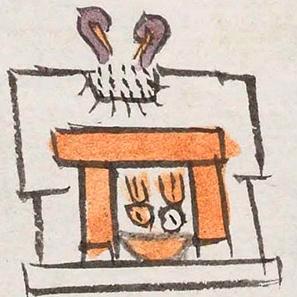Iztacalco (Mdz17v)
This simplex glyph for the place name Iztacalco primarily features a building (calli) where salt (iztatl) is being made. The -co locative suffix is not shown visually, but perhaps the building provides a semantic locative. Unlike many images for calli, the entryway to this one faces the viewer. One can see into the entrance, where orange water drops into an orange bowl. The building has a hole in the roof, where smoke or steam emerges. Small dots in the region of the hole seem to refer to the resulting salt (iztatl).
Stephanie Wood
The implication is that this is a location where salt is extracted from lake water through a heating/evaporation process. Berdan and Anawalt (Codex Mendoza, 1992, p. 231) refer to a similar interpretation by Clark (1938 2:22). Berdan and Anawalt also note that Iztacalco was a settlement on an island in Lake Tetzcoco (which was a saline lake). It may be that salt is only used here to produce the sound "izta," and the intention may really be white (iztac) house. If that is the case, then we should spell the place name Iztaccalco, which is the preference of Miguel León-Portilla..
Stephanie Wood
yztacalco. puo
Iztacalco [or Iztaccalco], pueblo
Stephanie Wood
c. 1541, or by 1553 at the latest
Stephanie Wood
buildings, houses, salt extraction, saline lakes, architecture, casas, edificios, arquitectura, sal, lago salino, Yztacalco, nombres de lugares

izta(tl), salt, https://nahuatl.wired-humanities.org/content/iztatl
iztac, white, https://nahuatl.wired-humanities.org/content/iztac
cal(li), house, building, https://nahuatl.wired-humanities.org/content/calli
-co (locative suffix), https://nahuatl.wired-humanities.org/content/co
"In the Salt House" (Berdan and Anawalt, 1992, vol. 1, p. 231)
Iztāc-calco = "En la casa blanca"
Miguel León-Portilla, "Los nombres de lugar en náhuatl," Estudios de Cultura Náhuatl 15 (1982), 43.
Codex Mendoza, folio 17 verso, https://digital.bodleian.ox.ac.uk/objects/2fea788e-2aa2-4f08-b6d9-648c00..., image 45 of 188.
The Bodleian Libraries, University of Oxford, hold the original manuscript, the MS. Arch. Selden. A. 1. This image is published here under the UK Creative Commons, “Attribution-NonCommercial-ShareAlike 3.0 License” (CC-BY-NC-SA 3.0).









